
The University of Saskatchewan is a Canadian public research university, founded on March 19, 1907, and located on the east side of the South Saskatchewan River in Saskatoon, Saskatchewan, Canada. An "Act to establish and incorporate a University for the Province of Saskatchewan" was passed by the provincial legislature in 1907. It established the provincial university on March 19, 1907 "for the purpose of providing facilities for higher education in all its branches and enabling all persons without regard to race, creed or religion to take the fullest advantage". The University of Saskatchewan is the largest education institution in the Canadian province of Saskatchewan. The University of Saskatchewan is one of Canada's top research universities and is a member of the U15 Group of Canadian Research Universities.
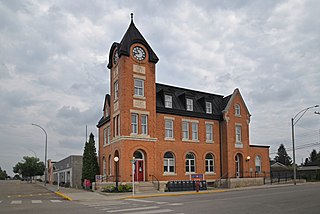
Battleford is a town located across the North Saskatchewan River from the city of North Battleford, in Saskatchewan, Canada.

The Canadian Bank of Commerce was a Canadian bank that operated from 1867 to 1961. It merged in 1961 with the Imperial Bank of Canada to form the Canadian Imperial Bank of Commerce, which today is one of Canada's Big Five banks.
Quill Lake is a village in the Canadian province of Saskatchewan within the Rural Municipality of Lakeside No. 338 and Census Division No. 10. It is 170 km east of Saskatoon and 200 km northeast of Regina.

Melfort is a provincial electoral district for the Legislative Assembly of Saskatchewan, Canada. The city of Melfort is the largest centre in the constituency.

Radville is a town in the Canadian province of Saskatchewan, in the RM of Laurier No. 38. It was incorporated in 1911 after being settled in 1895. Highway 28 and Highway 377 pass through the town. Nearby communities include the village of Ceylon, 23 km to the west, and the city of Weyburn, 51 km to the north-east. Major nearby urban centres include Regina, which is 148 km to the north, and Moose Jaw, which is 143 km north-west.

Fort Battleford was the sixth North-West Mounted Police fort to be established in the North-West Territories of Canada, and played a central role in the events of the North-West Rebellion of 1885. It was here Chief Poundmaker was arrested, and where six Cree and two Stoney men were hanged for murders committed in the Frog Lake Massacre and the Looting of Battleford. In reference to the hanging, Prime Minister John A. Macdonald said in a letter that "the executions... ought to convince the Red Man that the White Man governs."
Wynyard is a town in eastern Saskatchewan, Canada, 132 kilometres (82 mi) west of Yorkton and 190 kilometres (120 mi) east of Saskatoon. Wynyard is surrounded by the Rural Municipality of Big Quill No. 308. It is located on the Yellowhead Highway just south of Big Quill Lake.

Esterhazy is a town in the south-eastern part of the Canadian province of Saskatchewan, 83 kilometres (52 mi) south-east of Yorkton along Highways 22 and 80. The town is in the Rural Municipality of Fertile Belt No. 183.

Fort de la Corne was one of the two French forts established on the Saskatchewan River in the 20 years between the end of La Vérendrye's push west from Lake Superior in 1731–1743 and the fall of New France in 1763.
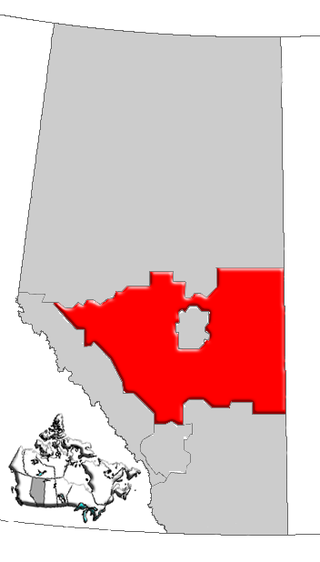
Central Alberta is a region located in the Canadian province of Alberta.
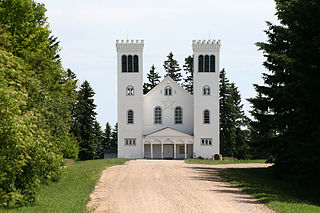
St. Peter's Abbey is in Muenster, Saskatchewan, Canada. It is the oldest Benedictine monastery in Canada. It was founded in 1903.

Naicam is a town in rural Saskatchewan, located 224 kilometres (139 mi) north of the province's capital city, Regina. In 2006 the population was 690. The name of the town is a combination of Naismith and Cameron, the railway construction contractors.

Muenster is a village in the Canadian province of Saskatchewan within the Rural Municipality of St. Peter No. 369 and Census Division No. 15. It is located 9 kilometres (5.6 mi) east of Humboldt on Highway 5. Muenster is named after the city of Münster, Germany.
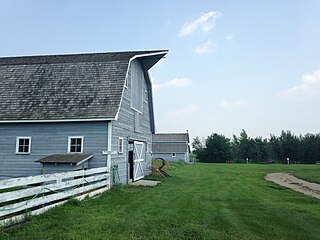
Seager Wheeler's Maple Grove Farm is a National Historic Site of Canada. Seager Wheeler's Maple Grove Farm was a farm owned and operated by agronomist Seager Wheeler (1868–1961) "Wheat King of the Prairies" or "The Wheat Wizard of Rosthern" who developed dry land farming techniques as well as fruit and wheat strains which could grow in a short prairie growing season followed by harsh winters. Seager came to Canada in 1885 and applied for his own homestead in 1890. His original homestead was located at NE Section 16 Township 38 Range 4 West of the 3rd Meridian, and he was aided by a loan from the Temperance Colonization Society Limited - Toronto Whereas the nearest present day town of Rosthern, Saskatchewan is located at Sec.35, Twp.42, R.3, W3. To get to the restored Seager Wheeler Maple Grove 185-acre (0.75 km2) Farm travel 7 km east of Rosthern. Five separate entries of wheat which were grown at this farm location during 1911 to 1918 won World Wheat Championships. Morris Bodnar, Member of Parliament for Saskatoon—Dundurn, commemorated Seager Wheeler's Maple Grove Farm as a National Historic Site of Canada on August 3, 1996 The site is honoured as the location where hardy wheat and fruit strains were developed which were well suited to the prairie climate and growing season.

Watson is a town of 777 residents in the Rural Municipality of Lakeside No. 338, in the Canadian province of Saskatchewan. Watson is located on the intersection of Highway 5 and Highway 6, the Canam Highway. Watson is approximately the same distance from Saskatoon which is to the west, and Regina to the south, which gives rise to its town motto, "Industrial Crossroads of Saskatchewan".

St. Brieux is a town in the Canadian province of Saskatchewan. It is located near Highway 368 and Highway 779. St. Brieux is located north of the village of Lake Lenore on the eastern shore of St. Brieux Lake. St. Brieux Regional Park and Golf Course is adjacent to the west side of the town.

The Big Muddy Badlands are a series of badlands in southern Saskatchewan, Canada, and northern Montana, United States, in the Big Muddy Valley and along Big Muddy Creek. Big Muddy Valley is a cleft of erosion and sandstone that is 55 kilometres (34 mi) long, 3.2 kilometres (2.0 mi) wide, and 160 metres (520 ft) deep.
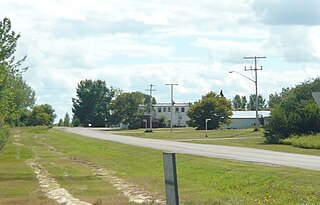
Hawarden is a village in the Canadian province of Saskatchewan within the Rural Municipality of Loreburn No. 254 and Census Division No. 11. The village is located on Highway 19 north of Strongfield, Loreburn, and Elbow.

Lac La Ronge Provincial Park is located in the boreal forest of the north central part of the Canadian province of Saskatchewan within the Canadian Shield. Situated in the Churchill River system, this provincial park has close to 100 lakes and more than 30 canoe routes, many of which follow old fur trade routes. Summer activities include camping, hiking, boating, fishing, and swimming. In the winter, there's cross-country skiing, snowmobiling, and ice fishing. Saskatchewan's highest waterfall is in the park. Nistowiak Falls are located north of Lac La Ronge along the Rapid River.


















